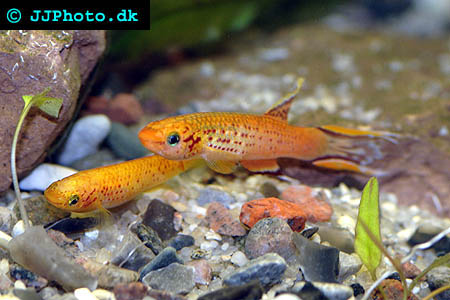Aphyosemion is one of several genuses that make up the Killifish group. All Aphyosemion species originates from Central and Western Africa, and they will typically be brightly coloured. Most Aphyosemion Killifish species have two intensely coloured bars along the top and bottom of their tails.
Killifish species from the genus Aphyosemion are among the most frequently kept Killifish species. Aphyosemion gardneri, Aphyosemion australe and Aphyosemion striatum are all suitable Aphyosemion species for a novice Killifish keeper. They will not grow larger than two inches and can be kept in community aquariums with pencil fish, tetras and other non-aggressive species. They will also do well with commonly kept algae eaters such as Ancistrus and Otocinclus.
Aphyosemion Killifish should be kept in planted aquariums, since they like to seek shelter among plants. It is recommended to use plants that provide the Aphyosemion Killifish with a good top cover, such as Riccia or Duckweed. Wild Aphyosemion Killifish live in soft waters, but they will usually tolerate ordinary tap water in the aquarium. If you live in a region with exceptionally hard tap water it is however unadvisable. A suitable diet for your Aphyosemion Killifish can have a flake food base and include some meaty foods as a supplement. Blood worms, grindal worms, brine shrimp and daphia will all be highly appreciated by your Aphyosemion Killifish.
If you intend to breed your Aphyosemion Killifish it is extra imperative to keep them in a planted aquarium. The male vs. female ratio in the aquarium is not very important when it comes to Aphyosemion Killifish. Most breeders choose to set up a separate breeding aquarium and move the potential parents from the community aquarium. Suitable breeding aquariums do not have to be larger than 10 – 20 litres. To ensure good water quality you can insert a sponge or box filter. Use de-chlorinated water, and fill the aquarium with lots of plants. Java moss will provide suitable spawning sites but Aphyosemion Killifish will also happily spawn on spawning mops. Place the potential parents in the breeding aquarium and make sure that the water quality is good and that the fish are given a nutritious diet. When the female Aphyosemion Killifish has deposited her eggs on the spawning site and the eggs have been fertilized by the male, you can let the parents stay in the breeding aquarium for roughly 10 days. As long as the parents are well fed it is highly unlikely that they will eat their eggs. Aphyosemion Killifish eggs will usually hatch after 12 to 20 days. The fry will recieve nutrition from their yolk sacs to begin with, but as soon as the yolk sacs are absorbed you should introduce the fry to small Brine Shrimp nauplii. Infusoria or mashed flake food are also suitable first foods for Aphyosemion Killifish fry. The easiest way of feeding older fry is to allow adult Daphnia to breed in the fry aquarium. The Aphyosemion fry will be too small to consume the adult Daphnia and the adult Daphnia will provide the fry with and endless amount of young Daphnia. The adult Daphnia is incapable of hurting the Aphyosemion fry, and will only feed on microscopic material in the water.

A pair of golden Aphyosemion australe. Copyright www.jjphoto.dk
If you wish to breed your Aphyosemion Killifish but have no extra aquarium that can serve as a breeding aquarium, you can of course let the Aphyosemion Killifish spawn in their normal aquarium. Even in a community aquarium at least a few Aphyosemion fry will usually survive. You can increase the chance of fry survival by keeping the aquarium very densely planted, and construct a thick cover by including Duckweed, Riccia or similar covering plants in the setup. A majority of the eggs and fry will still be eaten, but at least some Aphyosemion offspring will usually be able to hide among the plants and avoid getting eaten. When the Aphyosemion fry is large enough they will leave their hiding spots and join the adult fish.
Didn't find the info you were looking for? Register for free and ask your question in our Aquarium forum !
Our knowledgeable staff usually responds to any question within 24 hours
Related Articles
Breeding Clown Killies. Epiplatys annulatus - Information about how to keep and breed clown killies.
Breeding Fundulopanchax gardneri Jos Plateau - A detailed guide on how to keep and breed this species.
Breeding Rivulus hartii - the Giant Rivulus - This killifish proved easy to breed and raise.
Breeding the Blue Gularis, Aphyosemion sjoestedti - A guide to keeping and breeding the blue gularis..
Cynolebias - Information about Cynolebias killi fish.
Epiplatys - Information about Epiplatys killi fish.
How to Make a Spawning Mop - Detailed instructions on how to make a killie spawning mop.
Killiefish - Information about Killiefish
Killies - The Plant Spawners - The permanent and the mop methods of spawning. Incubation methods raising the fry.
Killie Mops - How to make and use these devices where killifish and other plant spawners can lay their adhesive eggs.
Nothobranchius - Information about Nothobranchius killi fish.
Shipping Killifish and Eggs. - A detailed article. Conditioning the fish. The water, bagging, containers. Carriers, receiving.
South American Killies - Cynolebias: True annual killifish that require slightly different treatment than Nothobranchius.
Spawning Cynolebias constanciae - This description of breeding this fish could apply equally well to other peat spawning annual killies.
Triggers - Triggers for killifish to breed and what you can do to convince those in your tanks that they should hatch.
Understanding Killifish Names - An explaination.



